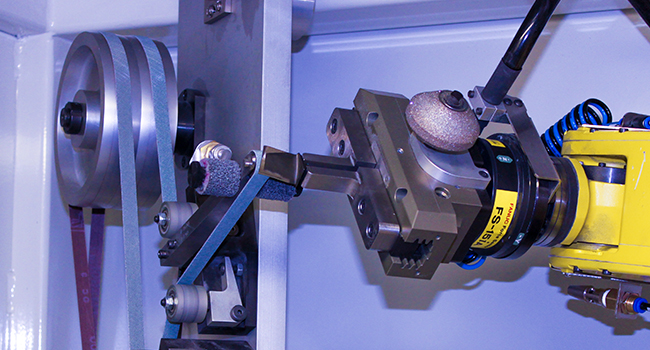
Airplane engine parts are altered during flights. As they are high added value parts, they are repaired to be used again. One of the main alterations happening to a part succeeding flights is erosion.
What Is Erosion?
Like a cliff that crumbles with time, the outline of jet engine blades slowly disintegrates in flight. This crumbling may be caused by dust, moisture, sand, salty air, pollution, by surreptitious visitors such as insects and birds or even sometimes by ground debris sucked by the engines. The entry of these elements into the engines is more significant during aircrafts’ take-off and landing. The environment has a big impact on the erosion of engine parts; a landing in a desert will be much more harmful to the blades than in a dry and pollution-free place. Yet, erosion is inevitable.
The impacts of blade erosion on jet engines are significant: the more erosion occurs, the more power the engine loses and the more fuel it consumes. As for the impacts on the blades, as the erosion is especially visible on their leading edges, this reduces their aerodynamics and accelerates their wear, thus reducing their service life.
Repairing Blades
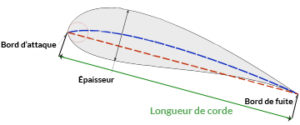
As previously mentioned, since these parts are expensive, they are repaired for reuse. For safety reasons, specific measures must be taken to ensure that the repaired blades remain within the OEM specifications, meaning they are suitable for use in an aircraft engine. This is when the nightmare of the MRO shops begins; the edge must be repaired while meeting the 3 following criteria: the profile, the thickness and the chord length.
When a repair is performed, these 3 elements are impacted at the same time. To perform an optimal repair of the part, it is important to know its current geometry. Since a misfortune never comes alone, the blades are not all altered in the same way in flight. As a result, this complex analysis must be performed for each of the parts to be repaired.
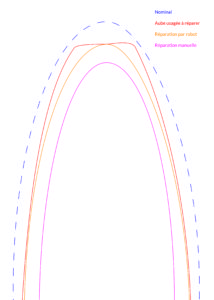
This repair consists mainly of reprofiling the blade’s leading edge. The diagram on the left compares the repair of a leading edge made by a human to one completed by a robotic machine. As demonstrated, the manual repair is less precise, it removes more material to the piece, thus decreasing its possible lifespan. For example, compressor blades can be manually repaired up to 3 times. Performing this operation with a robotic machine including a precise vision system makes it possible to repair the part a fourth time, because the machine removes a minimum of material, while recreating a profile suitable for the flight. But the profile is not the only element to consider! The thickness and chord length are also reduced during a repair. This is when the reality hits: there is no magic solution.
The Optimal Repair
When analyzing an eroded blade to prepare for repair, we must choose the impact on the 3 interrelated critical elements (profile, thickness and chord length) that will allow the longest service life of the part, including a possible future repair. New automated technologies offer two repair alternatives: the scale down or the shift of the nominal, i.e. the original part’s design profile. These two solutions each have their pros and cons.
Nominal Scale Down
Take the nominal profile of the part and scale it down so it fits into the remaining material.
+ Profil
– Thickness
+ Chord length
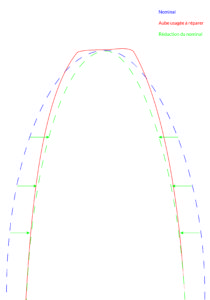
Nominal Shift
Take the nominal profile of the part and move it down so it enters the remaining material.
+ Profil
+ Thickness
– Chord length
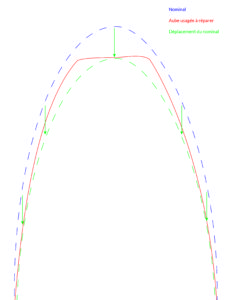
While scaling down the nominal may make the part too thin, it is the chord length that is at risk when shifting the nominal. How to choose the best option? First you need to understand the question! Currently, since these parts’ repair is done manually in most factories, the managers do not feel they have that kind of control over their processes.
Once the question is understood and analyzed, there is unfortunately no right answer; a compromise must be made, combining options, based on the geometry of the part to be repaired and the shop’s priorities. It is therefore important to analyze each piece with the desired quality and longevity in mind, which is crucial in repairing aircraft engine parts.
The End of The Nightmare?
Aircraft engine’s blades erosion is a phenomenon that causes a lot of hassle to factories when they repair parts. Robotic systems are a solution to this nightmare, but changing the repair philosophy is the biggest obstacle to the insertion of these technologies in factories. Let’s be realistic, work still needs to be done to change paradigms, but also so that robotic systems can meet all the challenges of the MRO shop’s reality.
Let’s keep hope and continue innovating to create the automated solution that will definitively end this nightmare.